Italian meringue buttercream is a classic buttercream used by both professional cake-makers and home bakers. This rich buttercream, made with butter, sugar, and egg whites, isn't too sweet, yet is very stable, can be flavoured, and is the best frosting for wedding cakes, for cake decorating and piping.
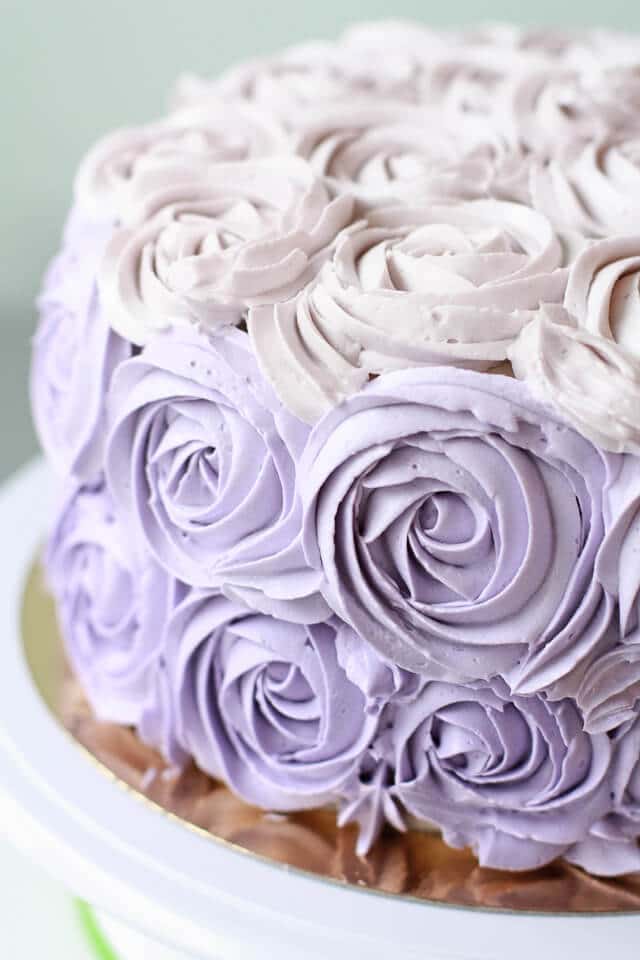
Here's an Italian meringue buttercream recipe in grams (and cups) and everything you need to know about making this frosting at home!
Jump to:
What is Italian meringue buttercream?
Italian meringue buttercream is a silky smooth frosting that is preferred by many trained pastry professionals because it isn't too sweet, it's a good blank canvas for incorporating flavours and colours, it can be piped and used to decorate elaborate cakes and cupcakes, especially wedding cakes, it can be used under fondant, and it is the most stable of the buttercreams.
Italian meringue and Swiss meringue buttercreams don't contain any powdered sugar so they are very different than American buttercreams. The flavour of Swiss and Italian meringue buttercream is more buttery than sweet, and this is unexpected to many North American tasters who are used to quick frostings made from powdered sugar and butter that are very sugary.
Italian meringue buttercream is more common in Europe, especially France. It was the main type of frosting I was taught at Le Cordon Bleu in pastry school, actually. The technique to make Italian meringue buttercream ensures that the ingredients are properly emulsified into a stable frosting.
Ingredients in Italian meringue buttercream
Italian meringue buttercream, like Swiss meringue buttercream, are very different than American buttercream. Italian meringue buttercream is made with 3 basic ingredients:
- Egg whites
- Granulated sugar
- Water
- Butter
There are other ingredients that you can add to Italian meringue buttercream, which are optional
- cream of tartar to stabilize the meringue
- salt to break up the gloopy egg whites so that they whip faster and/or to add a little flavour to the buttercream
- vanilla extract (or other flavour extracts) to give the Italian meringue buttercream a little more flavour and a sweet taste
Remember, unlike American buttercream, Italian meringue buttercream does not contain powdered sugar. It's sweetened with sugar syrup instead.
How do you make Italian meringue buttercream?
To make Italian meringue buttercream, you start with an Italian meringue that is whipped with butter to emulsify the mixture and form a smooth buttercream frosting, as the name would suggest. Italian meringue is one of 3 types of meringues that you can make (French, Swiss, and Italian). They are all made with egg whites and sugar, but the mixing method is different:
- For French meringue, there is no heat involved. Egg whites are whipped while slowly incorporating sugar. This is the same method as for a chocolate pavlova. The French meringue is easier to make, but it's also less stable than the others because it's only stabilized with some sugar. French meringue is not used to make buttercream, generally, probably because it's not stable enough. Note that French buttercream is not made from French meringue, unlike Swish and Italian. French buttercream is made from a "pâte à bombe" and butter. The pâte à bombe is made from egg yolks whipped with hot syrup (cooked to soft ball stage).
- For Swiss meringue, the egg whites are whipped with the sugar over a double-boiler. This allows you to gently heat the egg whites so that you can slowly build up a stable meringue with gentle heating. Direct heat would cook the egg whites otherwise. Heating the egg whites creates a more stable meringue. The Swiss meringue can be mixed with butter after cooling to make a Swiss meringue buttercream. Swiss meringue is technically easier to make than Italian meringue. However Swiss meringue is also not as stable as Italian meringue and therefore neither is the buttercream. Still, Swiss meringue buttercream is stable enough for most purposes.
- For Italian meringue, the egg whites are whisked alone (or with a fraction of the sugar to avoid over-whipping the meringue!). Meanwhile, the sugar is mixed with water and heated to make a syrup. The syrup is cooked to between soft ball stage and up to firm ball stage (234-240 °F or 112-115 °C, and up to a maximum 250 ºF or 121 ºC) before pouring over the meringue slowly while whisking. This hot sugar syrup creates the most stable meringue possible: Italian meringue. The meringue is whipped until it's cooled, at which point it can be piped or you can incorporate butter to make an Italian meringue buttercream (recipe below). Italian meringue and Italian meringue buttercream are the most stable because of the way they are made. Italian meringue is also used to make macarons, not to be confused with macaroons.
How to determine soft ball stage for Italian meringue
To make Italian meringue and Italian meringue frosting, the temperature of the sugar syrup is key because your sugar syrup should be at the soft ball stage. To determine if the syrup has cooked enough, you can:
- Measure the temperature of sugar syrups with a thermometer.
- Use an instant-read thermometer if you can. I measured the temperature with a Thermapen which is very fast at registering temperatures and temperature changes, but a probe thermometer with a longer cable like the ChefAlarm would be better because then you don't have to hold it with your hands, which would be much less dangerous to use than my hand-held setup. Every second counts when you are heating sugar syrups. If you heat the syrup too long (to the hard ball stage), you may have trouble when you pour it over the whipped egg whites: you may end up with some hardening of the syrup and difficulties properly incorporating the syrup in the whipped egg whites.
- Measure the temperature of sugar syrups without a thermometer, by hand. For this, you will need a bowl of ice water. When you want to check the temperature, remove the saucepan from the heat. Take a small sample of the syrup and drop it into the ice water bath:
- If the syrup disappears and dissolves right away, then you haven't cooked the syrup enough. Put the saucepan back on the stove to cook it more
- If the syrup forms a soft ball in ice water that can be flattened between your fingertips, you know your syrup is at 234-240 °F or 112-115 °C. Be sure to roll the ball between your fingers and squeeze it to feel the texture.
- If the syrup forms a firm ball in ice water that is firm but still pliable, but not hard, you know your syrup is just under 249 ºF or 121 ºC, the limit for making Italian meringue
- If the syrup forms a hard ball in ice water, your syrup may be too hot and the water content will be too low to make Italian meringue properly
Higher temperature syrups for Italian meringue
Some pastry chefs recommend cooking syrups to a higher temperature (even as high as 121 ºC which is bordering on the hard ball stage). The idea behind this is the hotter sugar syrup will raise the temperature of the egg whites high enough in an attempt to pasteurize them. This may be something to keep in mind and test if food safety is a concern for you.
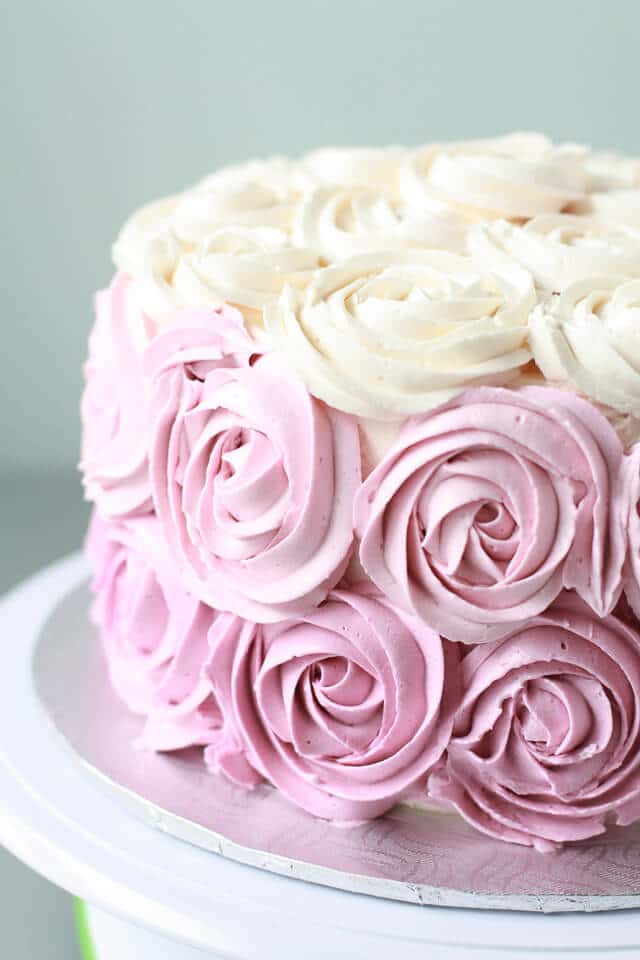
Use a stand mixer to make Italian meringue buttercream
I learned how to make Italian meringue by hand with a giant balloon whisk, but let's face it: the ease of preparation and the result obtained with the stand mixer cannot be beaten. It's a struggle to make Italian meringue by hand with a whisk and I do not recommend it because you have to whip the egg whites continuously in a bowl while slowly drizzling the hot syrup in an even stream.
This step can be quite dangerous given that the sugar is cooked to between 112 ºC and 121 ºC. For this type of recipe and preparation, even a hand mixer can be dangerous. I can only recommend making Italian meringue buttercream with a stand mixer, like the KitchenAid stand mixer.
To make a large batch of Italian meringue buttercream based on 10 egg whites, you will need a larger mixer bowl, so it's best to make a big batch in a 6-quart or 7-quart mixer, whereas for smaller batches based on 5 to 7 egg whites, you can use a smaller 5-quart stand mixer.
The following recipe will fit in a 5-quart bowl, but it will be tight.
If you don't have a stand mixer and would like to make a frosting with a hand mixer, try this thick cream cheese frosting or this milk chocolate frosting, for example. The frosting for the Milk Bar birthday cake could also be made with a hand mixer. And you could make this raspberry frosting, which is an American buttercream flavoured with a concentrated raspberry purée.
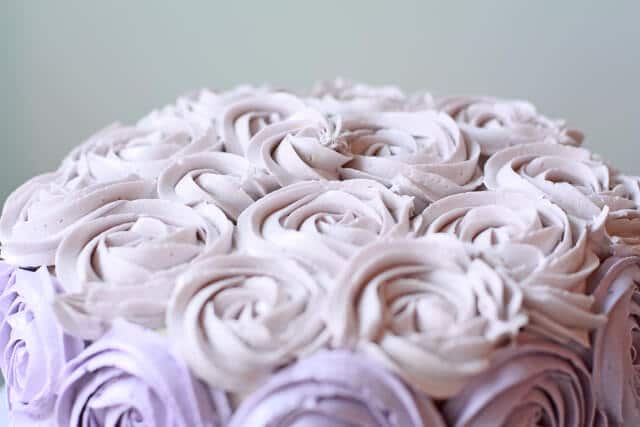
How much buttercream do you need to frost and decorate a cake?
It is actually much easier to make a double batch of IMBC than a single batch because the whipped egg whites (before the addition of the syrup) fill the 6.5 Qt mixer bowl enough that adding the syrup is much easier, without worrying about spraying it over the beater! From now on, I will be making my IMBC in double batches (therefore 10 egg whites at a time) instead of single batches. I'll freeze the leftovers.
To assemble and decorate a 3-layer 8-inch cake, you will need one 10-egg white batch of Italian meringue buttercream. I assembled and lightly frosted the cake with the plain, uncoloured buttercream, then I split the remainder (~900 grams) into three bowls and coloured each with a different amount of violet gel colour (from Ateco/Spectrum).
To colour buttercreams that have a high butter/fat content, I prefer to use gel food colours. I have even used oil-based gel food colours also called candy colours. Oil-based candy food colours blend into buttercreams easily, whereas water-based gel food colours may not incorporate properly, leading to an uneven colour.
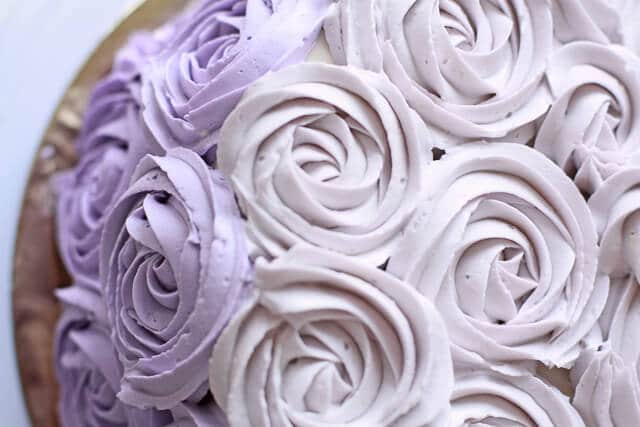
I used i am baker's fantastic rose cake tutorial for the piping using a 1M tip from Wilton (which you can buy on Amazon). I found it difficult to properly fill the space and estimate the rose size to pipe, but I think I will soon get the hang of this. Also, my two darker lilac colours are too similar. I guess I need to work on my colouring technique too!
Italian meringue buttercream recipe
Before making the recipe for Italian meringue buttercream, make sure to read through the frequently asked questions about making buttercream and about working with buttercream so that you are familiar with what can go wrong when you are making this recipe, how to fix it, when to use this buttercream and how.
Frequently asked questions about making Italian meringue buttercream and working with it
Italian meringue buttercream is a versatile frosting for cakes and cupcakes. Here are a few answers to common questions about this type of buttercream:
- Why does Italian meringue buttercream curdle? Italian meringue buttercream may curdle because of temperature differences between the butter and the Italian meringue. Ideally, when you start to incorporate butter into the meringue, both the butter and the meringue will have the same temperature. This way, they will combine easily and yield a stable, smooth, homogenous buttercream. Unfortunately, this doesn't always happen due to temperature differences. If the meringue is colder than the butter or the butter is too soft and warm, the buttercream will curdle.
- How do I fix curdled buttercream? Italian meringue buttercream is an emulsion between meringue (containing water) and butter (fat). When it curdles, the emulsion is broken, or hasn't formed. In order to salvage Italian meringue buttercream after it has curdled, you will have to whip it a lot in order to homogenize the frosting and emulsify the fat with the water. Sometimes you may have to whip for upwards of 10 minutes before it becomes smooth and silky. There are other techniques that involve playing with the temperature of the buttercream:
- put the mixer bowl in the fridge to chill the buttercream slightly, then whip it again for several minutes to obtain a silky smooth texture
- heat the outside of the bowl with a hair dryer to partially melt a portion of the buttercream, then whip it again for several minutes to homogenize the mixture
- microwave a small portion of the buttercream to melt it: this is a technique some pastry chefs use to warm up a small portion of the mixture, then incorporate the melted buttercream back into the big mixer bowl of frosting, while whipping. Eventually, you should obtain a smooth, silky texture.
- What if my Italian meringue buttercream is runny after I added all the butter? If your Italian meringue buttercream is runny after you've incorporated all the butter, this means the meringue was too warm when you added the butter, which melted as you mixed it in. You can fix it by chilling the mixture in the fridge for about 3o minutes (more or less) and then re-whipping to form a silky, smooth buttercream. Next time, be absolutely sure your meringue has cooled to room temperature and is the same temperature as your butter before mixing the two!
- Can I make Italian meringue buttercream without a thermometer? Yes, you can, but you will need to know how to check sugar syrup consistency by hand with a bowl of ice water.
- If the syrup disappears and dissolves right away, then you haven't cooked the syrup enough. Put the saucepan back on the stove to cook it more.
- If the syrup forms a soft ball in ice water that can be flattened between your fingertips, you know your syrup is at 234-240 °F or 112-115 °C. Be sure to roll the ball between your fingers and squeeze it to feel the texture.
- If the syrup forms a firm ball in ice water that is firm but still pliable, but not hard, you know your syrup is just under 249 ºF or 121 ºC, the limit for making Italian meringue.
- If the syrup forms a hard ball, you've overcooked it and will need to start over.
- Does Italian meringue buttercream crust? Unlike American buttercream frostings, which are sweetened with powdered sugar, Italian meringue buttercream does not crust as it is sweetened with meringue.
- Can I add powdered sugar to Italian meringue buttercream if it is runny or soupy? Though it's very tempting to reach for powdered sugar when Italian meringue buttercream goes wrong, this is a mistake. By adding more sugar, you are completely changing the recipe and you will not end up with the perfect silky, smooth buttercream you were trying to make. The beauty of Italian meringue buttercream is that when things go wrong, there is usually a way to fix it (by whipping the buttercream, by heating it gently, by chilling it briefly...). Please don't add powdered sugar to Italian meringue buttercream like you would with American buttercreams.
- Does Italian meringue buttercream have to be refrigerated? All buttercreams and cakes frosted with buttercreams, including Italian meringue buttercream, should be refrigerated for food safety. Italian meringue buttercream has a high butter content and therefore isn't very pleasant when served fridge-cold. Never serve a cake frosted with Italian meringue buttercream cold. It's just not good that way! I like to take the frosted cake out of the fridge at least 30 minutes before serving to let the Italian meringue buttercream come to room temperature.
- Does Italian meringue buttercream hold up in hot weather? Italian meringue buttercream is more stable than Swiss meringue buttercream and French buttercream. For this reason, it is the best buttercream to use if you will be displaying a wedding cake in hot weather. However, do not store any frosted cake in direct sunlight and make sure to expose the frosting to the least amount of heat possible or for the shortest amount of time.
- Can Italian meringue buttercream be frozen? You can absolutely freeze Italian meringue buttercream. In fact, I encourage you to make bigger batches and freeze portions for later. When you are ready to use it, simply defrost the buttercream in the fridge overnight, then place in a stand mixer and whip it. If the mixture looks curdled, you can use a blow dryer to heat the outside of the mixer bowl and mix a small portion of the frosting, then continue whipping. Honestly, it takes a ton of whipping to revive the buttercream, but it will eventually return to a perfect, stable frosting with some work and patience. Then you can use it to frost cakes and it will pipe beautifully if you want to decorate a cake with defrosted whipped buttercream, or use it under fondant, if you prefer.
📖 Recipe
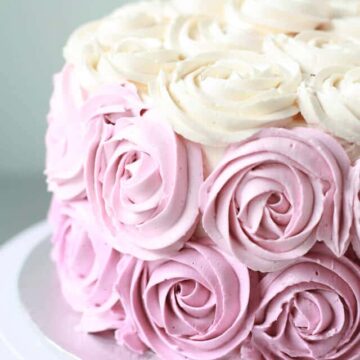
Italian Meringue Buttercream
Ingredients
- 125 mL water
- 560 grams granulated sugar divided
- 300 grams large egg white(s) from 10 large eggs approximately
- 1 pinch cream of tartar
- 908 grams unsalted butter room temperature
- 2 pinches Diamond Crystal fine kosher salt
- 2 teaspoon pure vanilla extract
Instructions
- Pour the water in a small saucepan. Top with the granulated sugar, reserving a ¼ cup. Don’t stir. Just put it on the burner on medium heat. Clip on your candy thermometer.
- Place the egg whites in the bowl of an electric mixer fitted with the whisk attachment. Add a pinch of cream of tartar. Start the mixer on medium-low to begin frothing the whites.
- When the sugar begins to boil, increase the speed of the mixer to medium-high. When the whites are at soft peaks, gradually add the reserved sugar. Continue beating to stiff (not dry) peaks.
- When the sugar reaches 112 ºC or 233 ºF (you can go up to 121 ºC or 250 ºF), remove the pan from the burner. Turn off the heat, unclip the thermometer and then slowly pour the hot sugar in a fine stream down the side of the bowl, being sure not to hit the beater (or it will splash!).
- When all the sugar is added, stop the mixer and scrape down the sides of the bowl with a spatula. Increase the speed to high and beat til the mixture has just about cooled (this takes a good 5–10 mins for such a large batch).
- When the meringue has cooled, start adding the butter, a tablespoon at a time, while the mixer is running on medium.
- When all the butter has been added, increase the mixer to high to beat until the buttercream forms and is smooth.
- Beat in the vanilla and the salt.

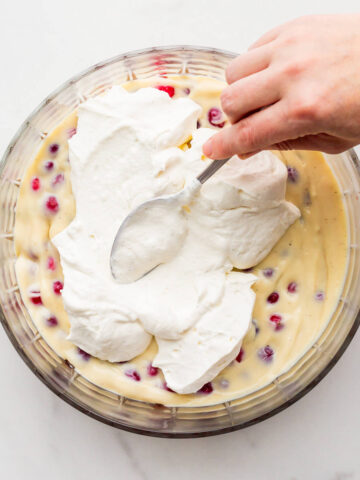
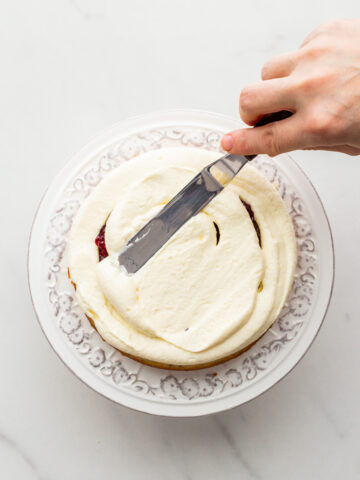
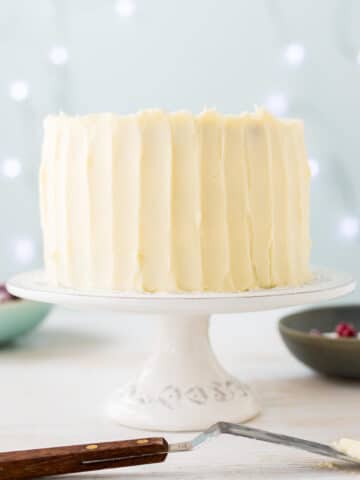
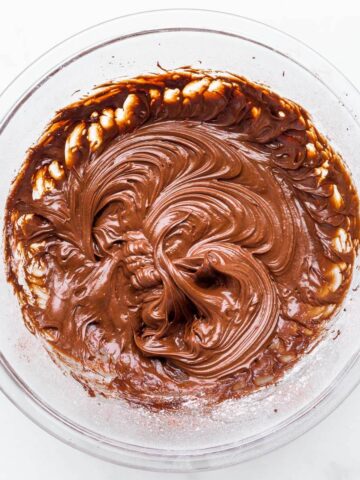
Angela says
Trying it now, will report back when I emerge from the mound of butter and sugar!! 🙂
Angela says
Hi, this is the first recipe/how to I have found via Google which I have total confidence in trying! Thanks 🙂 I was wondering if you had tried a white chocolate version and how this is best incorporated; by adding straight cooled melted chocolate after all the butter has been beaten in? Also any advice on how much chocolate for this sized batch of IMBC?
Janice says
Hi Angela, I have found that sometimes, adding white chocolate can smooth out a curdled butttercream, which is great for days when buttercream is misbehaving 😉
I would say for a batch of this size, I'd add 300-400 grams melted and cooled white chocolate. If I were you, I'd start by adding 300 grams, and go from there.
By the way, I have added white chocolate to Swiss meringue buttercream successfully and French buttercream too. I am sure it will work! Good luck and let me know how it goes!
Unknown says
Thanks so much for your quick response! This gives me some relief and I will make sure that we keep it as cool as possible for as long as possible 🙂
Unknown says
These cakes are beautiful! I'm wondering about the heat stability of this recipe. It looks like the icing was probably pretty easy to work with. Do you know how well it could stand up to heat? I'm decorating a cake for an outdoor wedding where it might be up to 90 degrees outside, though the cake with not be in full sun. I'm trying to decide on an IMBC versus a regular BC (no shortening).
Janice Lawandi says
I know for a fact, out of all the "real buttercreams" (by that I mean those that are egg/sugar syrup based, and finished with butter), the Italian meringue buttercream is the most stable at high temperatures. And usually, for summer/high heat events, cake makers often use Italian meringue buttercream, instead of Swiss. It should hold up, but make sure the cake is decorated cake is chilled overnight to give it a "cool start". That being said, I cannot recommend leaving any cake in hot weather for too long a period, simply for hygienic reasons... Good luck!
Unknown says
These cakes are beautiful! I'm wondering about the heat stability of this recipe. It looks like the icing was probably pretty easy to work with. Do you know how well it could stand up to heat? I'm decorating a cake for an outdoor wedding where it might be up to 90 degrees outside, though the cake with not be in full sun. I'm trying to decide on an IMBC versus a regular BC (no shortening).
Alejandra Jimenez says
Congratulations!!, I'll try this recipe, thanks 🙂
Charlotte says
These look gorgeous! I would definitely order some cakes from you!
Michelle says
Can you say YUMMMMMMM! That looks amazing!
Are you now selling your cakes privately? Can I do a blog post on you and your amazing talents? Send me an email...!
Jan says
Thanks, Michelle! I will send you an email 😉
Dafna Y. says
This is AMAZING!
What will I do with this blog? Every recipe makes me wanna run to the kitchen and start baking... Not that I'm complaining... Not really 🙂
Way to go, both the pink and the violet cakes look beautiful.
Maggie says
Congratulations!! These are some gorgeous cakes! I was going to make some swiss meringue buttercream (my go-to recipe) for cupcakes tonight but maybe I'll try your Italian Meringue instead...I've been curious to try one for awhile. 🙂